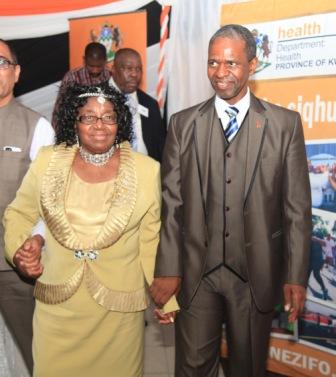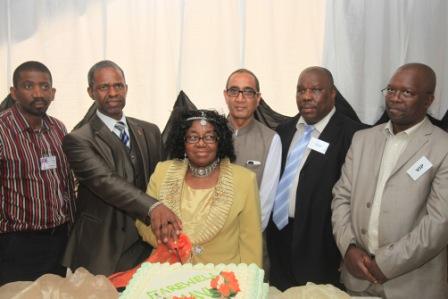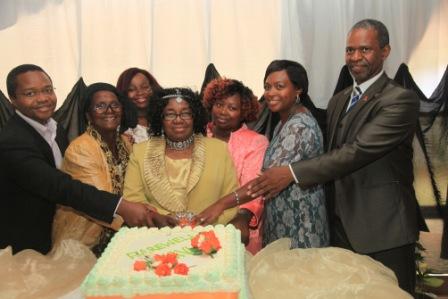| 31 March 2015 It is with a heavy heart that I
stand here today to bid farewell to one of our outstanding and
illustrious managers.
I stand proud of the decision that we took in 2010 to recall Prof Gumbi
from retirement and entrust her with a responsibility to lead this
historic hospital.
Prior to her arrival here, the residents of this beautiful township of
Umlazi had lost all hopes and were infamously referring to Prince
Mshiyeni Memorial Hospital as UMSHIYAZAFE.
In my capacity as both the Health MEC as well as the Chairperson of the
ANC EThekwini Region; I have lost count of the meetings and sessions I
had with the local leadership and community members in general to listen
and address their complains about this institution.
It will also be prudent to note that it was not only the residents of
Umlazi that were suffering, but those at Makhutha; Folweni; uMbumbulu;
Malukazi and all the uninsured people in the South of this city.
Wisdom informed us that due Government processes of advertising for the
CEO position at that time could not take us anywhere. We had to find a
very strong leader to turn this institution around – provide direction
to the staff members and give hope to our people.
To this very last day; I repeat, we do not regret the decision we made
in deploying Prof. Rachel Vuyiswa Gumbi here.
Her qualities speak for themselves. We had known that she was the fifth
Rector and Vice-Chancellor of the University of Zululand and the first
woman to hold that position at that University.
We had also gleaned from her curriculum vitae that she had been a Chief
Director: Human Resource Development at the National Department of
Health. A position that entailed working together with different strands
including Health Councils; Professional Associations; Non-Governmental
Organizations, Employee organizations as well as Unions.
It was explained to her that the community being served here were saying
they rather have no hospital at all than to be continuously subjected to
substandard healthcare.
What she had to deal with, amongst other problems, entailed:
- Negative image due to attitudes of
personnel
- Negative image due to media reports
- Health personnel working in silos
- Lack of cordial interaction with the
community
- Lack of support from the Local Leaders
- Long periods for dispensing medicine
- Infrastructure not user friendly for
people with disability (no lifts; no ablution facilities, no ramps
etc.)
- Debilitated paint of the buildings
(affecting the ecstatic’s including the entrance)
- Congestion in the medical out- patients
As a team player and an innovative person, today
we all stand proud of her leadership.
The transformation taking place here did not escape the attention of our
President, Honourable Jacob Zuma, who when addressing the Nursing Summit
in Sandton had this to say:
‘The attitudes must change, we must shorten the waiting times or delays
in receiving care and health services personnel must ensure that all
facilities are clean and tidy at all times.
Health professionals must prevent the transmission of infections and
cross-infections inside hospitals and clinics, and ensure a reliable
provision of basic medicines and supplies.
These are just some of the few improvements that are expected from all
public health facilities.
If we implement these provisions, visits to our facilities will be a
more tolerable and pleasant experience for our people.
It will be as pleasant as what we have been informed has happened at
Prince Mshiyeni Hospital in uMlazi, Durban.
The hospital has been turned around from being the worst hospital in the
country to one which is being praised by patients and the community for
good service, efficiency and friendly staff.’
Yes, we can all attest to that as Prince Mshiyeni Memorial Hospital is
today a secured healthcare institution abiding to SAFETY AND SECURITY
for its patients; staff and Infrastructure through:
- Installation of CCTV Cameras at the
main gate and pharmacy.
- Installation of electric doors in
paediatrics wards, nursery, maternity and ICU.
- Mash wires in the ward.
- Ablution facilities for people with
disability.
- Renovation of the ablution facilities
in the wards and outpatients departments.
- Revamping of the maternity theatre.
- Vinyl sheeting, stripping and sealing
of floors in the wards.
- Provision of Granite tiles in all the
frontline areas with a high flow of patients.
Our communities are the biggest beneficiaries in
efforts made in reducing WAITING TIMES. Truth of the matter is that,
waiting times:
- At Pharmacy in 2010 was up to 3 days – today
it is 48 minutes
- Patient Administration in 2010 was 2 hours
and today it is 45 minutes
- Waiting time for Out-Patients in 2010 was 8
hours and ; today it is 2 hours
CLEANLINESS has also improved as a result of the:
- Employment of a Manager for cleaning services
as well as two Supervisors.
- Procurement of the 60 genitor trolleys as
required by the National Core Standard.
INFECTION PREVENTION AND CONTROL measures
are also adhered to as evident in the:
- Reduction in the number of Health care
acquired infections with no outbreaks having happened during her
tenure.
- Procurement of hand basins and elbow action
taps for all clinical areas
Confidence has been reinstated even among the
personnel as shown through the filling of key Staff posts:
- In 2010 this Hospital had 20 Specialists and
today it has 40
- In 2010 it had 12 Clinical Managers; today
they are 15
- In 2010 there were 102 Medical Officers and
today they are 120
- Same with Sessional Doctors who were 12 in
2010 and 20 in 2015
- Staff development is also taking place with
10 Personnel currently doing research for their post-graduate
studies (PhD and Masters)
Indeed, all these innovations have had a positive impact on both the
staff as well as the clients being served.
Professor Gumbi has helped in fostering a culture of togetherness by
promoting interaction with staff through focus group discussion and
staff Izimbizos.
She understood Homer Rice, the Philosopher very well, when he advised:
‘You can motivate by fear and you can motivate by reward. But both those
are only temporary. The only lasting thing is self-motivation.’’
Indeed positive feedbacks and accolades are now being received as
problems and challenges are identified and solved accordingly through
the enactment of:
- Client Satisfaction Surveys quarterly for
in-patients and out-patients.
- Waiting Time Surveys in all frontline areas
quarterly
- Staff satisfaction surveys
- Management conducting walk-about of the
institution
- Implementation of the National Core Standards
We are also happy to notice that the Hospital is
no longer regarded as the leprosy judging by partnerships it has forged
with both the public and private sector resulting in:
- Mangosuthu University of Technology (MUT)
providing split fans for the wards for cooling of patients
- University of KwaZulu Natal (UKZN)
- For research with HIV and AIDS (RHH)
- Provision of toys and decorations for
paediatric wards
- SAPREF - Donating 18 air-conditioners for the
Medical Wards (6 per ward)
- ABSA - Donating toys for the paediatric wards
- Robin Hood Foundation – providing Baby
layettes (100 per cycle) with the last lot given in March 2015.
- Gideon’s Bible Society – Supplying bibles for
personnel and patients periodically.
- Cyrene Full Gospel Church – with the donation
of layettes and babies’ clothes for new born babies – ongoing
partnership.
- CZEH REPUBLIC - Providing Intensive Care beds
and Maternity Care beds
- HPP – Donating Bone density Machine
- Umlazi Plaza Butchery & Investments –
erecting the shelter for patients to protect from sun and rainy
weather conditions
- 120 Chairs donated by our Specialist in the
Internal Medicine.
- Vulindlela Holdings – donating a projector
and moveable screen now used for meetings, education and training
e.g. Keep Fit Programme by internal and external personnel.
To the future Chief Executive Officer for this Hospital, we say; keep up
the momentum and be mindful of the fact that this institution is now
being used as a BENCHMARKING SITE FOR SHARING OF BEST PRACTICES by:
- Free State Province
- Addington Hospital
- St Mary’s Hospital
- Hlabisa Hospital
- Edendale Hospital
- RK Khan Hospital
As we bid farewell to Prof Gumbi; we also want to express our gratitude
to the community at large for giving us a chance and support to turn
this Hospital around.
Lastly, we thank the Gumbi family for their generosity in allowing us to
snatch their granny from the comforts of retirements – to come back and
serve the people.
It is a journey worth travelled and worthy to be recorded in our annals
as a Department.
Prof Gumbi, you were God sent.
Fare thee well.
MEC Dr Sibongiseni Dhlomo then announced Dr Tshabalala as the new CEO
for Prince Mshiyeni Memorial hospital.
|

Prov RV
Rachel Gumbi with THE MEC for Health in Kwazulu-Natal Dr Sibongiseni
Dhlomo

The New
CEO for Prince Mshiyeni Memorial Hospital Dr Sandile Tshabalala, Th MEC
for Health in Kwazulu-Natal Dr Sibongiseni Dhlomo, Prof Rachel Gumbi, Mr
Ajesh Maharaj, Dr Mandlenkosi Maziz Acting Deputy Director General
Specialised Services and Clinical Support and Siphiwo Yose Ethekwini
District Manager

Mr
Dumisani Gumbi;Mrs Nokuthula Dlamini Gumbi;Ms Sinqobile Gumbi, Prof
Rachel Gumbi, Ms Thokozani Gumbi, Mrs Bongiwe Magudulela and THE MEC for
Health in Kwazulu-Natal Dr Sibongiseni Dhlomo |